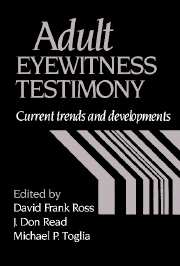Book contents
- Frontmatter
- Contents
- List of contributors
- Preface
- Part I Cognitive, physical and social processes and factors influencing eyewitness recall and identification
- Part II Lineup construction and collection of testimony
- Part III Whom to believe? Distinguishing accurate from inaccurate eyewitnesses
- 13 Distinguishing accurate from inaccurate eyewitness identifications: A reality monitoring approach
- 14 Decision times and eyewitness identification accuracy in simultaneous and sequential lineups
- 15 Individual differences in personality and eyewitness identification
- 16 Eyewitness identification confidence
- 17 Expectations of eyewitness performance: Jurors' verdicts do not follow from their beliefs
- 18 The appraisal of eyewitness testimony
- Name index
- Subject index
13 - Distinguishing accurate from inaccurate eyewitness identifications: A reality monitoring approach
Published online by Cambridge University Press: 04 August 2010
- Frontmatter
- Contents
- List of contributors
- Preface
- Part I Cognitive, physical and social processes and factors influencing eyewitness recall and identification
- Part II Lineup construction and collection of testimony
- Part III Whom to believe? Distinguishing accurate from inaccurate eyewitnesses
- 13 Distinguishing accurate from inaccurate eyewitness identifications: A reality monitoring approach
- 14 Decision times and eyewitness identification accuracy in simultaneous and sequential lineups
- 15 Individual differences in personality and eyewitness identification
- 16 Eyewitness identification confidence
- 17 Expectations of eyewitness performance: Jurors' verdicts do not follow from their beliefs
- 18 The appraisal of eyewitness testimony
- Name index
- Subject index
Summary
Eyewitness identifications tend to be one of the most compelling types of evidence presented in police investigations and criminal trials. One extensive survey of real-life cases, for example, revealed a 73 percent conviction rate for trials in which the only evidence brought against the defendant was eyewitness identification testimony (Devlin, 1973). Yet psychological research has shown that eyewitness testimony can be unreliable. Human memory is fragile and easily influenced by both external and internal factors.
Given this state of affairs, it is not surprising that social and behavioral scientists have focused on identifying the factors that indicate whether a witness has provided accurate or erroneous testimony. And to a great extent these researchers have been successful in determining the general factors that prompt accuracy and error in eyewitness identification. Many variables, such as the time of day, duration of exposure, presence or absence of a weapon, interrogation procedure, and lineup construction can enhance or impair an individual's memory for an event (for reviews, see Loftus, 1979; Wells, Seelau, Rydell, & Luus, this volume).
In another sense, however, this research leads to disappointment. Ask legal or criminal justice officials what they need from psychological research, and the answer will involve some sort of test or examination they can give to specific witnesses involved with particular cases that establishes the accuracy or inaccuracy of individual identification. Unfortunately, given the necessary focus of behavioral research on general factors, psycholegal researchers have been unable to find or create a test to be used with particular witnesses in specific cases.
- Type
- Chapter
- Information
- Adult Eyewitness TestimonyCurrent Trends and Developments, pp. 273 - 299Publisher: Cambridge University PressPrint publication year: 1994
- 11
- Cited by

